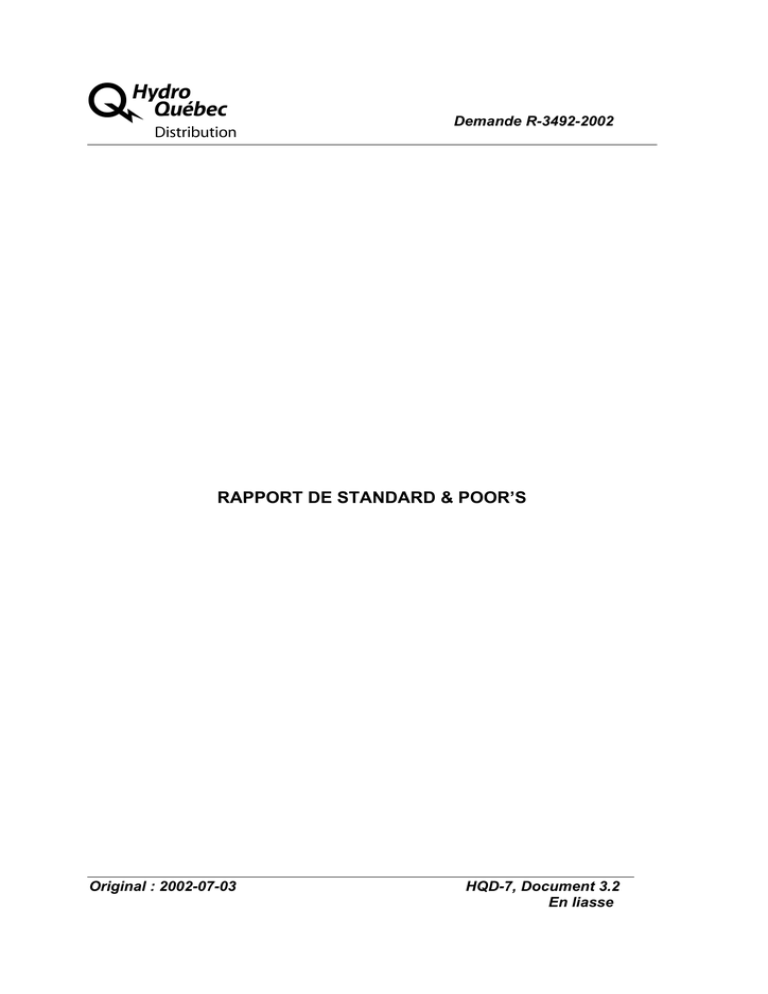
A
Demande R-3492-2002
RAPPORT DE STANDARD & POOR’S
Original : 2002-07-03
HQD-7, Document 3.2
En liasse
Publication date: 06-Sep-2000
Reprinted from RatingsDirect
Summary: Hydro-Quebec
Analyst: Valerie E Blair, Toronto (1) 416-202-6012
Rationale
The senior unsecured debt, senior secured debt, and commercial paper
ratings on Hydro-Quebec are based on the timely debt service guarantee
provided by the utility's owner, the Province of Quebec (A+/Stable/A-1+).
With the break-up of the former Ontario Hydro into five distinct successor
companies, Hydro-Quebec has become Canada's largest vertically integrated
electric utility, generating and distributing power to 3.4 million residential,
commercial, and industrial customers in Quebec. It also supplies power to
nine municipal systems, one regional cooperative, and some 15 electric
utilities in the Northeast U.S., Ontario, and New Brunswick.
In 1998, net income for the utility fell to 7.7% of revenues from 9.3% the
previous year. This resulted from lower domestic sales attributed to the
devastating January 1998 ice storm, coupled with milder-than-average
temperatures for most of the year, and higher electricity and fuel purchases
than in 1997, because of low precipitation overall last year. Offsetting these
factors to some extent were higher firm and short-term sales outside Quebec,
up by almost 37% over 1997 levels. Of note, repairs and reinforcements to
Hydro-Quebec's transmission system following the ice storm were completed
by December 1998, with the bulk of the cost having been assumed by the
provincial and federal governments.
According to the 1998-2002 strategic plan, hydro rates in Quebec are to
remain at their current levels until 2002 for all customer categories. Thus, the
province continues to enjoy among the lowest rates in North America.
Hydro-Quebec is continuing discussions with Newfoundland and Labrador
Hydro Corp. about the possibility of jointly developing the remaining
hydropower potential of the Churchill River in Labrador. This project in its
entirety would require an investment of approximately C$10 billion over a
decade, adding 3,200 megawatts of capacity to the systems of the two
utilities. However, before the project can be initiated, approvals from the
aboriginal and local communities in Labrador, as well as environmental
approvals, must be obtained.
Hydro-Quebec's debt-to-capital ratio was approximately 75% last year, similar
to 1997. With the capitalization ratio at, or slightly above, 25% in each of the
past two years, the utility has been required to make dividend payments in
1997 and 1998 to its owner, Quebec, for the first time in almost a decade.
This report was reproduced from Standard & Poor's RatingsDirect, the
premier source of real-time, Web-based credit ratings and research from an
organization that has been a leader in objective credit analysis for more
than 140 years. To preview this dynamic on-line product, visit our
RatingsDirect Web site at www.standardandpoors.com/ratingsdirect.
Standard & Poor's.
Setting The Standard.
1 of 2
Published by Standard & Poor's, a Division of The McGraw-Hill Companies, Inc. Executive offices: 1221
Avenue of the Americas, New York, NY 10020. Editorial offices: 55 Water Street, New York, NY 10041.
Subscriber services: (1) 212-438-7280. Copyright 2002 by The McGraw-Hill Companies, Inc.
Reproduction in whole or in part prohibited except by permission. All rights reserved. Information has
been obtained by Standard & Poor's from sources believed to be reliable. However, because of the
possibility of human or mechanical error by our sources, Standard & Poor's or others, Standard &
Poor's does not guarantee the accuracy, adequacy, or completeness of any information and is not
responsible for any errors or omissions or the result obtained from the use of such information. Ratings
are statements of opinion, not statements of fact or recommendations to buy, hold, or sell any
securities.
2 of 2

![Garneau english[2]](http://s3.studylib.net/store/data/009055680_1-3b43eff1d74ac67cb0b4b7fdc09def98-300x300.png)
